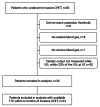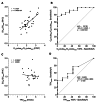Cardiopulmonary exercise test to detect cardiac dysfunction from pulmonary vascular disease
- PMID: 38468264
- PMCID: PMC10926602
- DOI: 10.1186/s12931-024-02746-w
Cardiopulmonary exercise test to detect cardiac dysfunction from pulmonary vascular disease
Abstract
Background: Cardiac dysfunction from pulmonary vascular disease causes characteristic findings on cardiopulmonary exercise testing (CPET). We tested the accuracy of CPET for detecting inadequate stroke volume (SV) augmentation during exercise, a pivotal manifestation of cardiac limitation in patients with pulmonary vascular disease.
Methods: We reviewed patients with suspected pulmonary vascular disease in whom CPET and right heart catheterization (RHC) measurements were taken at rest and at anaerobic threshold (AT). We correlated CPET-determined O2·pulseAT/O2·pulserest with RHC-determined SVAT/SVrest. We evaluated the sensitivity and specificity of O2·pulseAT/O2·pulserest to detect SVAT/SVrest below the lower limit of normal (LLN). For comparison, we performed similar analyses comparing echocardiographically-measured peak tricuspid regurgitant velocity (TRVpeak) with SVAT/SVrest.
Results: From July 2018 through February 2023, 83 simultaneous RHC and CPET were performed. Thirty-six studies measured O2·pulse and SV at rest and at AT. O2·pulseAT/O2·pulserest correlated highly with SVAT/SVrest (r = 0.72, 95% CI 0.52, 0.85; p < 0.0001), whereas TRVpeak did not (r = -0.09, 95% CI -0.47, 0.33; p = 0.69). The AUROC to detect SVAT/SVrest below the LLN was significantly higher for O2·pulseAT/O2·pulserest (0.92, SE 0.04; p = 0.0002) than for TRVpeak (0.69, SE 0.10; p = 0.12). O2·pulseAT/O2·pulserest of less than 2.6 was 92.6% sensitive (95% CI 76.6%, 98.7%) and 66.7% specific (95% CI 35.2%, 87.9%) for deficient SVAT/SVrest.
Conclusions: CPET detected deficient SV augmentation more accurately than echocardiography. CPET-determined O2·pulseAT/O2·pulserest may have a prominent role for noninvasive screening of patients at risk for pulmonary vascular disease, such as patients with persistent dyspnea after pulmonary embolism.
Keywords: Cardiopulmonary exercise test (CPET); Echocardiography; Pulmonary embolism; Pulmonary vascular disease; Stroke volume augmentation.
© 2024. The Author(s).
Conflict of interest statement
Summary of conflict-of-interest statements: The authors report no conflicts of interest and no financial support relevant to this work.
Figures




